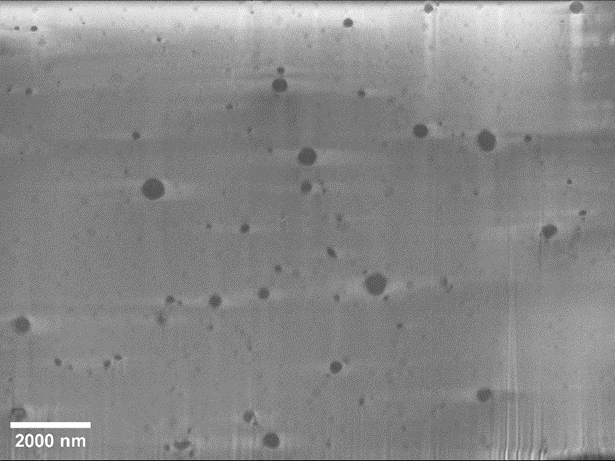Particle size analysis of milk using Cryo FIB-SEM
- Abstract number
- 87
- Presentation Form
- Poster
- Corresponding Email
- [email protected]
- Session
- Poster Session Two
- Authors
- Fraser Laidlaw (1), Joe Bradley (1), Alexander Boggon (2), Ngai Ying Denise Li (1), Job Thijssen (1), Wilson Poon (1)
- Affiliations
-
1. University of Edinburgh
2. University of Exeter
- Keywords
Soft matter, Cryo FIB-SEM,
- Abstract text
Milk is a colloidal fluid of fat globules and casein micelles, suspended in a mixture of lactose, whey protein and water. The size of fat globules in milk is one of the primary factors affecting the quality of milk, such as creaming rate and texture, while the casein micelle size is thought to have an effect on the processing of milk into other dairy products, for example in cheesemaking. Knowledge of the particles sizes in milk is therefore important for many aspects of the dairy industry.
Figure 1: Cross section of whole milk from Slice-and-View image stack. Image has been processed to remove curtaining artefacts. Dark contrast particles are fat globules while lighter contrast particles are the casein micelles. Some fat globules appear to be below 200nm in diameter – smaller than literature values.
Characterisation of milk in industry is most commonly via particle size distribution methods such as laser scattering techniques. Results from such methods show that milk exhibits an overall bimodal distribution, whereby it is generally accepted that the larger population is fat globules (0.2 - 2 μm diameter) and the smaller population is casein micelles (0.1 - 0.2 μm diameter), although fat globules below 0.2 μm diameter have been measured. Particle sizing using optical microscopy techniques can be challenging however, especially in multimodal systems where larger particles dominate light scattering over smaller particles, and where particles are of a different composition. Care must be taken when particle sizing using conventional techniques in these systems so as to size the correct particles. Direct sizing techniques are therefore required to accurately size the particles and identify the type of particle.
Here we employ high-pressure freezing and Cryo FIB-SEM nano tomography to attempt to extract accurate particle size information of both the fat globules and casein micelles in skimmed and whole milk samples. Image stacks were aligned and processed to remove curtaining and local charging artefacts, and background corrected before image segmentation.
Preliminary results, Figure 1, show that fat globules, with sizes less than 200nm diameter are present in milk. This overlap in the sizes of the fat globules and casein micelles may affect the interpretation of the results of particle size analysis using conventional techniques. Here we will present some preliminary particles size distributions measured for the fat globules and casein micelles, and discuss the image processing workflow carried out to extract the particle size information.

